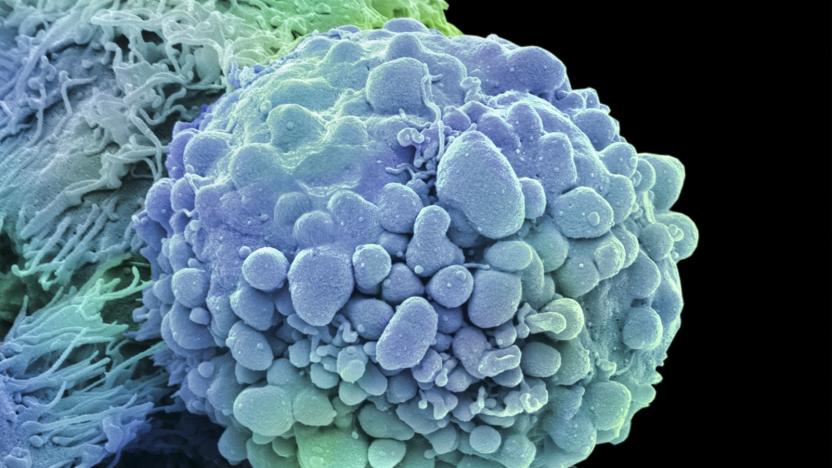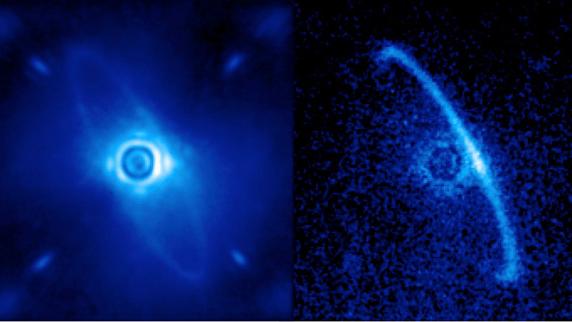LawrenceLivermoreNationalLaboratory
Latest

Jupiter is the oldest planet in the Solar System
Jupiter's ancient name really is well-deserved: according to a new study, the king of the planets isn't just the largest in the Solar System, it's also the oldest. A team of researchers from Lawrence Livermore National Laboratory in California and the University of Munster in Germany have determined that Jupiter's core was already 20 times the size of Earth merely 1 million years after the sun took shape 4.6 billion years ago. Since newborn stars tend to release energy that blows away gas and dust for planet formation, the gas giant must have had to absorb materials very, very fast.

Watch these declassified nuclear test films on YouTube
There's something both beautiful and unnerving about a mushroom cloud. The United States conducted around 216 atmospheric nuclear tests between 1945 and 1992, many taking place in Nevada and the Pacific Proving Grounds. Now, rare videos of those detonations are declassified and available to the public for the first time.

NVIDIA helps the US build an AI for cancer research
Microsoft isn't the only big-name tech company using AI to fight cancer. NVIDIA is partnering with the US Department of Energy and the National Cancer Institute to develop CANDLE (Cancer Distributed Learning Environment), an AI-based "common discovery platform" that aims for 10 times faster cancer research on modern supercomputers with graphics processors. The hardware promises to rapidly accelerate neural networks that can both spot crucial data and speed up simulations.

Police could soon identify you by your hair proteins
Police and archaeologists regularly depend on DNA evidence for identification, but it has a serious flaw. DNA degrades under environmental conditions like heat and light, so it may be useless even if you have a ton of samples. However, Lawrence Livermore researchers have a better way: they've established a method of identifying humans based on hair protein markers. The markers are much more resilient than DNA (scientists found markers in remains about 250 years old) while remaining unique, with no one person sharing the same marker count and patterns. You only need a few hairs to get a result, too, and the ultimate goal is to pinpoint someone using a single strand of hair.

Hyperloop taps into government research to float pods
One of the two competing Hyperloop companies has made a major announcement concerning how it's going to make high speed transport a reality. Hyperloop Transportation Technologies has signed a deal with the Lawrence Livermore National Laboratory to harness Inductrack, a form of passive repulsion technology. Traditional MagLev systems require a constant supply of power, adding cost and complexity to most bullet train systems. By comparison, passive repulsion operates with a single series of magnets that can be mounted on each capsule. That's going to make Hyperloop a lot cheaper and easier to maintain, which should hopefully encourage more cities to consider buying one.

Scientists 3D print 'live' blood vessels
It's no longer a rare feat to 3D print blood vessels. Printing vessels that act like the real deal, however, has been tricky... until now. Lawrence Livermore researchers have successfully 3D printed blood vessels that deliver nutrients and self-assemble like they would in a human body. The key is to print an initial structure out of cells and other organic material, and then to augment it with bio ink and other body-friendly materials. With enough time, everything joins up and behaves naturally.

Americans are using more energy, but green tech is softening the blow
It may be tough to satisfy the US' seemingly never-ending thirst for energy, but clean power sources are at least helping to soften the impact. Researchers at the Lawrence Livermore National Laboratory have determined that Americans' energy use climbed 1 percent year-over-year in 2014, but its carbon emissions hardly budged at all. In fact, they were down significantly for coal and petroleum-based power. While some of that decline is due to industry using less-than-clean natural gas, it's also helped by big jumps in solar and wind energy, which respectively grew by 33 and 8 percent.

Scientists get meaningful energy from laser-based nuclear fusion
Researchers have long sought to generate significant energy from laser-based nuclear fusion, and it appears that they're finally making some headway. Lawrence Livermore National Laboratory reports that laser blasts in September and November produced more energy from hydrogen fusion reactions than they'd put into the hydrogen -- the first time that's happened. The key was an extra dose of caution. The lab team altered the laser pulse so that it didn't break a shell used in the necessary fuel-compression process, improving the energy yield. We're still far from seeing laser fusion reactors when just 1 percent of the power reached the hydrogen in the first place. However, the output was much closer to what scientists have been expecting for years -- laser fusion is now more of a realistic possibility than a pipe dream. [Image credit: Dr. Eddie Dewald]

Gemini Planet Imager photographs alien worlds in just a minute
Although it has been possible to take direct photos of exoplanets for a few years, the technology involved has been low-resolution and slow -- it can take up to an hour to get a crude shot of a dimly-lit world. It's much easier with the recently launched Gemini Planet Imager (GPI), though. Scientists have released early images from the Chile-based instrument that took a mere minute to capture, and reveal more detail than ever before. Researchers have already spotted a full dust ring (seen at left) and the spectrum of a young planet. The imager's secret ingredient is a deformable, etched silicon mirror that can correct for atmospheric distortion much more effectively than traditional glass. GPI is still relatively untested, but it should ultimately let astrophysicists focus on quality over quantity when studying alien worlds.

Sequoia supercomputer breaks simulation speed record, 41 times over
While we've seen supercomputers break records before, rarely have we seen the barrier smashed quite so thoroughly as by Lawrence Livermore National Laboratory's Sequoia supercomputer. Researchers at both LLNL and Rensselaer Polytechnic Institute have used planet-scale calculations on the Blue Gene/Q-based cluster to set an all-time simulation speed record of 504 billion events per second -- a staggering 41 times better than the 2009 record of 12.2 billion. The partnership also set a record for parallelism, too, by making the supercomputer's 1.97 million cores juggle 7.86 million tasks at once. If there's a catch to that blistering performance, it's not knowing if Sequoia reached its full potential. LLNL and RPI conducted their speed run during an integration phase, when Sequoia could be used for public experiments; now that it's running classified nuclear simulations, we can only guess at what's possible.

Livermorium and Flerovium take a seat at the Periodic Table
Just when we thought those pesky scientists had stopped messing with the Periodic Table, the International Union of Pure and Applied Chemistry goes and ratifies another two. The pair of elements were discovered in partnership between the Flerov Laboratory of Nuclear Reactions, Joint Institute for Nuclear Research in Russia and the Lawrence Livermore National Laboratory in the States. Element 114 has taken on the spell-check-worrying nomenclature Flerovium (Fl), while 116 becomes Livermorium (Lv). Eagle-eyed readers will notice that both take a name from the labs where they were discovered, the former named after Georgiy N. Flerov and the latter after Ernest O. Lawrence -- both atomic pioneers in their respective countries. The official names will get their first official publication in July's edition of Pure and Applied Chemistry. We guess those textbook makers will be rubbing their hands in glee at all those revised editions it'll sell next term. [Image courtesy of the BBC / Talkback Thames]

GE partners with Livermore Labs to explore efficient aircraft fuel injectors (video)
What would you do with six months of dedicated access to 261.3 teraflops of computational power? As you ponder that question, consider the case of GE Global Research, which has just announced its participation with the Lawrence Livermore National Laboratory in an effort to design more powerful and efficient aircraft engines by way of computer simulation. Specifically, GE will partner with researchers from Arizona State University and Cornell University to study the unsteady spray phenomena that's thought to be ideal for fuel injectors. Through Large Eddy Simulation, GE hopes to discover an ideal spray pattern and fuel injector design, and reduce its number of lengthy, real-world optimization trials. While the research is initially aimed at aircraft engines, the knowledge gained from these experiments may work its way into GE's other products, such as locomotive engines and land-based gas turbines. For a glimpse into GE's current research, be sure to hop the break.

Periodic Table welcomes two new, ultraheavy elements, jury still out on the names
If you bump in to the Periodic Table of Elements today, be sure to give it a hearty Mazel Tov, because it's just welcomed two new members to the family. Yesterday, the International Union of Pure and Applied Chemistry (IUPAC) officially recognized elements 114 and 116, crediting the discovery to scientists from Russia's Joint Institute for Nuclear Research and the Lawrence Livermore National Laboratory, in California. Boasting atomic masses of 289 and 292, respectively, the new man-made additions are now the heaviest elements on record, seizing the belt from copernicium (285) and roentgenium (272). As with most heavyweights, however, both decay within less than a second, making it difficult for researchers to get a grasp of their chemical properties. Nevertheless, both apparently had enough credibility to survive IUPAC's three-year review process, paving the way for the real fun to begin. At the moment, 114 and 116 are known, rather coldly, as ununquadium and ununhexium, respectively, though their names will eventually be jazzed up -- sort of. The Russian team has already proposed flerovium for 114 (after Soviet nuclear physicist Georgy Flyorov), and, for 116, the Moscow-inspired moscovium, which sounds more like an after shave for particularly macho chemists. IUPAC will have the final say on the matter, though one committee member said any proposed names are likely to be approved, as long as "it's not something too weird." Head past the break for a full, and somewhat obtuse PR.

World's largest laser opens for business in California
Another day, another laser... well, not so fast. This particular laser just so happens to officially carry the "world's largest title." Built at Lawrence Livermore National Laboratory in Livermore, California, and housed in the National Ignition Facility -- or NIF -- it was completed at the end of March, and has just now been officially dedicated and opened for business. The laser inside the three-football field-sized building will aim to create a "star" on earth by focusing 192 beams at a pea-sized target, generating temperatures over 100 million degrees and pressure over 100 billion times the earth's atmosphere. The process will create nuclear fusion -- the reaction that powers the sun and the stars. it sounds pretty complicated, and we'd hate to be in town if something goes awry, but we're crossing our fingers for the team! Hit the read link for much, much more information about the project.[Via Physorg]





